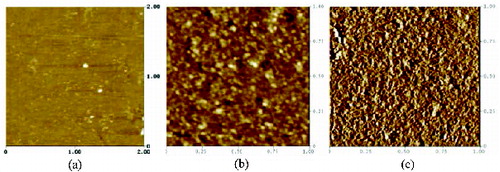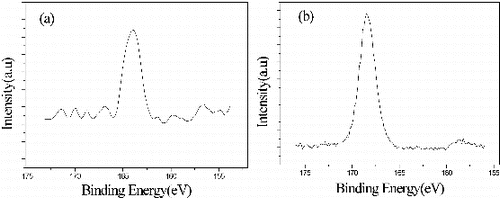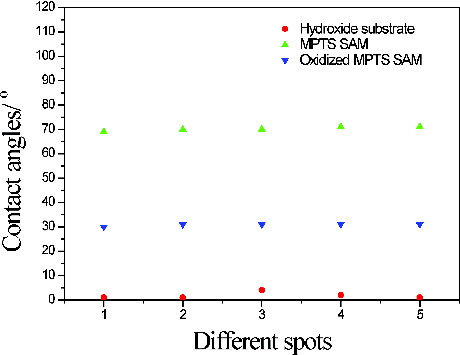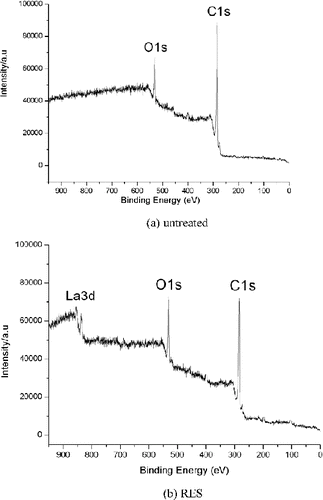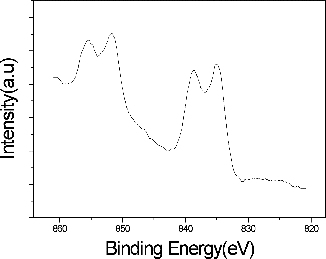Abstract
Carbon nanotube (CNT) composite thin films were prepared on a single-crystal silicon substrate by a self-assembling process from a specially formulated solution. Rare earth solution (RES) surface modification and appropriate acid-treatment methods were used to functionalise carbon nanotubes (CNTs). Silane coupling regent (3-mercaptopropyl trimethoxysilane (MPTS)) was prepared first. The terminal thiol groups (–SH) in the film was oxidised to sulphonic acid groups (–SO3H) in situ to enhance the film with good chemisorption ability. Treated Caron nanotubes were deposited on the oxidised MPTS–SAM by means of chemisorption with the SO3H group. The surface energy, chemical composition, phase transformation and surface morphology of the films were analysed using contact angle measurements, X-ray photoelectron spectroscopy (XPS), scanning electron microscope (SEM) and atomic force microscopy. As a result, a conclusion could be made that some lanthanum elements react with –SO3H groups on the surface of the substrate by a chemical bond, which will improve the bonding strength between the films and the CNTs. Since the CNT thin films were well adhered to the silicon substrate, it might find promising application in the surface-modification of single-crystal Si and SiC in microelectromechanical systems (MEMS).
1. Introduction
Self-assembled monolayers (SAMs) are ordered molecular assemblies formed by the chemical adsorption of an active surfactant on a solid surface, which have attracted much attention in the field of material science in the past decade.[Citation1–2] As a typical example, CNTs and rare earth (RE) have been applied as important materials in high mechanical strength and fracture toughness applications, owing to their superior properties such as good friction-reducing, wear-resistant properties, excellent corrosion resistance and high anti-scuffing ability.[Citation3–7] There are many techniques, including sputtering, plasma spraying, vapour deposition, sol-gel process and electrochemical deposition available to prepare thin films. However, these techniques are expensive or limited by complicated processes. The self-assembled monolayer (SAM) has the advantageous characteristics of a well-defined structure, a strong head group-substrate binding and a dense packing of hydrocarbon chains. Indeed, SAM can considerably reduce friction and adhesion and found use in various microelectromechanical systems (MEMS) devices.[Citation8–10]
Over the years, CNTs have attracted much interest from researchers because they possess many unique properties,[Citation11,12] such as high-tensile and flexural strength, high-elastic modulus and self-lubrication property. If CNTs are aligned to form nanotube composite films,[Citation13–15] they can provide both mechanical support and self-lubrication for the films. Such unique properties of CNTs make them potential to be used in the lubrication of the interfaces between moving components in MEMS.
However, it is known that CNTs are not compatible with all solvents because of their chemical inertness, and it is very hard to obtain a suitable modifier to improve their surface activities. These lead to poor dispersion capability and weak bonding of CNTs when they are used in composite films as reinforcing elements. Many researches have been conducted to enhance the adhesion between carbon nanotube and substrate by surface treatment of carbon nanotubes.[Citation16]
RES surface treatment has been successfully applied to improve the adhesion between carbon fibres and their matrices.[Citation17–19] In this study, RES was applied in the CNTs surface modification, and CNTs composite thin films were prepared on glass substrates by self-assembly. A number of techniques, such as XPS, AFM and SEM, were used to study the structures and properties of the thin films. The fabrication and the characterisation of the films on sulphonated MPTS–SAM prepared by a self-assembly technique from a specially formulated solution are also addressed in the paper. It was also found that CNT composite films have good friction reduction and wear resistant property. We will report detailed results in another paper.
2. Experimental
2.1. Sample preparation
2.1.1. Materials
The purified carbon nanotubes (purchased from Shenzhen Nanotech Port Co. Ltd, China) were produced from carbon monoxide by the chemical vapour deposition (CVD) method. Single-crystal silicon plates were used as substrates for the transfer of SAM film. The plates were cut into pieces with a surface size of approximately 10 × 10 mm2 before cleaning and modifying 3-mercaptopropyl trimethoxysilane (MPTS) were purchased from Sigma Aldrich (Deisenhofen, Germany) and used as received. All other chemicals used in chemical manipulations were of reagent grade. Deionised water used in this study was obtained from the Barnstead Nanopure apparatus.
2.1.2. Preparation process of CNT composite films
The MPTS–SAM sample was prepared according to the literature. With proper prehydration, hydrolysed silane molecules form covalent bonds to the oxidised silicon substrate via condensation reaction of silanol groups. Silicon substrates were immersed for 30 min in Piranha solution (H2SO4/H2O2 = 7/3 (v/v)) at 90 °C to produce hydroxy radicals on the surfaces. Then, the substrates were carefully rinsed with deionised water and dried. Subsequently, the hydroxide Si substrates that have -OH groups were dipped into the dehydrated benzene solution containing 0.5 mM of MPTS solution for 12 h to form self-assembled MPTS–SAM. In order to remove physisorbed ions or molecules, the substrates were cleaned ultrasonically with chloroform, acetone and deionised water in turn, dried for 1 h at 120°C in air, then cooled in a desiccator. The oxidisation of the –SH groups to the desired –SO3H groups was carried out by dipping the substrates into a solution of 30% nitric acid at 80°C for 1 h, followed by washing with distilled water and drying in nitrogen.
Two steps of surface modification methods were used in the carbon nanotube treatment: acid modification and RES modification (the reaction procedure is shown in ). The 2 mg of chemically modified CNTs were thoroughly dispersed in 20 ml of N,N-dimethylformamide(DMF) with sonication for 2 h at room temperature. Then the substrates deposited with sulphonated MPTS–SAM were immersed in the resulting mixed solution at 90°C for 12 h, to allow the assembly of CNT composite films. Finally, the substrates were cleaned ultrasonically with deionised water to remove other physisorbed ions or molecules and dried for 2 h at 120°C, and then cooled in a desiccator.
2.2. Experimental apparatus and measurements
In this study, static contact angles were measured in ambient air (relative humidity 40%) using an OCA-20 contact angle measurement device (DataPhysics Instruments Gmbh). Distilled water was used as the spreading reagent. Measurements were performed on at least three samples, and were made at a minimum of three different spots on each sample. The values reported here were the averages of at least six measurements for each sample.
XPS analysis was performed on a PHI-5702 multifunctional X-ray photoelectron spectroscope (Physical Electronics, USA) operating with Mg Kα irradiation () at a pass energy of 29.4 eV, with the binding energy of contaminated carbon (C1s: 284.6 eV) as the reference. The resolution for the measurement of the binding energy was about ±0.3 eV.
The phase transformation and surface morphologies of the silicon substrates and films were investigated on an OPTON CSM950 SEM and an SPM-9500 Atomic force microscope (NanoScope IIIa) produced by Shimadzu Corporation (Kyoto, Japan) using ‘constant force’ mode. The cantilever was made of Si3N4 and had a tip radius less than 20 nm. All scans were taken at the room temperature in air.
3. Results and discussion
3.1. Characterisation of MPTES–SAM
3.1.1. AFM analysis
shows a 1.0 μm × 1.0 μm AFM images of hydroxide silicon substrate, MPTS–SAM and oxidised MPTS–SAM. The mean roughness (Ra) for the scanned area are 0.159 nm, 0.527 nm and 0.2 nm, respectively. It implies that the MPTS molecules had been adsorbed to the substrate and that the self-assembled MPTS–SAM is sequential and has a well-oriented compact structure. When the terminal groups (–SH) of SAM in the topmost layer to the air/silane were completely oxidised into sulphonate groups (–SO3H) in 30% HNO3 solution, the surface roughness decreased. From , it is seen that the surfaces of the hydroxide silicon substrate and the sulphonated MPTS–SAM are very smooth and homogeneous with surface mean roughness in the range of 0.1–0.2 nm, which is consistent with that reported elsewhere. The cross-section analysis for the image of the oxidised MPTS–SAM also indicates that the surface is extremely flat and it is useful for the deposition of the CNT thin film.
3.1.2. XPS results
In the high-resolution scan of XPS spectra of the surface, the S2p peak located at 163.eV is the characteristic of sulphur in ( (a)). For the sample surface obtained by oxidising the surface of MPTS film in situ with 30%
, the appearance of an S2p binding energy peak at 168.4 eV is the characteristic of sulphur in
groups ( (b)). This indicates that the oxidising procedure has an effect on the terminal groups (
).
3.1.3. Contact angle
The contact angles of hydroxide substrates, oxidised MPTS–SAM and MPTS–SAM are,
and
, respectively (as seen in ). When the terminal groups (
) of self-assembly monolayers were oxidised into sulphonate ones (
) by dipping in a solution of 30%
, the contact angle of samples decreased from
to
. It indicates that those films were successfully obtained in our work, which is necessary for the formation of CNTs composite film.
3.2. Characterisation of the deposited CNT thin film on sulphonated MPTS–SAM 204
3.2.1. XPS results
shows typical wide-scan photoelectron spectra of (a) untreated carbon nanotube and (b) RES-treated carbon nanotube. Apart from strong C-signals (C1s photoelectron), the spectrum of the untreated carbon nanatube () shows relatively weak O-signals (O1s) that is due to the near surface oxygen-containing functional groups of the nanotubes. The effect of RES treatment can be distinctly seen in where the spectrum shows strong oxygen lines and a weak graphite line.
The difference in binding energies for La3d is very small and de-convolution of the peaks is necessary to analyse XPS data (). The dominant peak at 853.0 eV was assigned to La3d in LaCl3. The 852.3 eV peak shows that the rare earth compounds are capable of coordinating and ionic combination reacting with organic functional groups (such as hydroxyl and carboxyl groups on the carbon nanotube) during the process of carbon nanotube treatment.
shows the XPS spectra of La3d on the surface of sulphonated MPTS–SAM coated with RE-modified CNT. The La3d core level band of surface also decomposes into four peaks at binding energies of 835, 838.9, 851.79 and 855.2 eV, but the characteristic of is 834.8 eV.[Citation20] It can be concluded that much of the La element could react with oxygen elements of
group on the surface of the substrate, which indicates that the CNT composite film has been successfully obtained in our work.
3.2.2. SEM analysis
shows a series of SEM images of as-deposited CNT thin film deposited on (a) MPTS–SAM, (b) mixed SAM and (c) sulphonate-functionalised SAM. From the SEM images presented in , a few of the CNTs are deposited on the MPTS–SAM. After the deposition of the CNT thin film on the sulphonated MPTS–SAM. The CNTs on the surface of the deposited film is obvious. The results in –(c) show the variation of the CNTs on the different deposition films. The number of CNTs is affected by the amount of the –SO3H on the substrate and the chemical structure of La, so it can be seen that the number of CNTs and chemical bonds between CNTs and films increase with the increase of –SO3H groups on the films.
Rare earth elements have a unique chemical activity, which depends on their special electron structure (- - - 4f 0–14). The rare earth compounds are capable of coordinating and ionic combination reacting with functional groups (such as hydroxyl (C–OH), carbonyl (C = O) and carboxyl (COOH) groups) on the glass substrates or the surfaces of CNTs.[Citation21] With the chemical combination between rare earths and functional groups, CNTs are strongly bonded with the substrate, which improves the load-carrying ability of the composite films and hence improves the tribological properties of the films.
4. Conclusions
The results presented here demonstrate that a silane-coupling reagent (3-mercaptopropyl trimethoxysilane) was self-assembled on a single-crystal silicon substrate to form a two-dimensional MPTS–SAM. The terminal groups (–SH) of the SAM in the topmost layer to the air/silane could be completely oxidised into sulphonate groups (–SO3H) in 30% nitric acid solution. The SAM provides both a high degree of surface acidity and net negative charge, thus promoting surface attachment of modified CNTs by RES containing species. Therefore, CNT thin films were formed on the oxidised MPTS–SAM, and different oxidation states of CNTs exist in the films as deposited. The SEM images showed CNT composite films can be obtained using a self-assembly technique through the chemical combination of rare earths with functional groups. On the basis of a detailed shape analysis of the La3+ XPS peaks, the true chemical shift resulting from the La3+ chemical state variation indicates that the composite film almost reacted with the substrate by chemical bond.
Acknowledgements
The authors would like to thank Instrumental Analysis Center, Shanghai Jiao Tong University, for their help. The project was supported by the National Natural Science Foundation of China (No. 50775139).
References
- Appelhans D, Ferse D, Adler HJP, Plieth W, Fikus A, Grundke K, Schmitt FJ, Bayer T. Self-assembled monolayers prepared from ω-thiophene-functionalized n-alkyltrichlorosilane on silicon substrates. Colloid Surf A: Physicochem Eng Aspects. 2000;161:203.
- Brechling A, Sundermann M, Kleineberg U, Heinzmann U. Thin Solid Films. 2003;433:281.
- Wong EW, Sheehan PE, Lieber CM. Nanobeam mechanics: elasticity, strength, and toughness of nanorods and nanotubes. Science. 1997;277:1971–1975.
- Falvo MR, Clary GJ, Taylor RM, Chi Jr V, Brooks FP, Washburn S, Superfine R. Bending and buckling of carbon nanotubes under larger strain. Nature. 1997;389:582–584.
- Treacy MM, Ebbesen JTW, Gibson JM. Exceptionally high Young's modulus observed for individual carbon nanotubes. Nature. 1996;381:678–680.
- Cheng X, Bai T, Wu J, Wang L. Characterization and tribological investigation of self-assembled la based thin films on glass substrates. Wear. 2006;260:745.
- Bhushan B, Israelachvili JN, Landmann U. Nanotribology: friction, wear and lubrication at the atomic scale. Nature. 1995;374:607.
- Dugger MT, Senft DC, Nelso GC. Microstructure and microtribology of polymer surfaces. ACS Symp Ser. 2000;741:455.
- Tsukruk VV, Bliznyuk VN, Hazel J, Visser D, Everson MP. Intralayer reorganization of photochromic molecular films. Langmuir. 1996;12:4840.
- Aizenberg J, Black AJ, Whitesides GM. Controlling local disorder in self-assembled monolayers by patterning the topography of their metallic supports. Nature. 1998;394:868.
- Ma PC, Kim JK, Tang BZ. Functionalization of carbon nanotubes using a silane coupling agent. Carbon. 2006;44:3232–3238.
- Li J, Cheng XH. Effect of rare earth solution on mechanical and tribological properties of carbon fiber reinforced thermoplastic polyimide composite. Tribol Lett. 2007;25:207–214.
- Arai S, Fujimori A, Murai M, Endo M. Excellent solid lubrication of electrodeposited nickel-multiwalled carbon nanotube composite films. Mater Lett. 2008;62:3545–3548.
- Li XF, Guan WC, Yan HB, Huang L. Fabrication and atomic force microscopy/friction force microscopy (AFM/FFM) studies of polyacrylamide – carbon nanotubes (PAM–CNTs) copolymer thin films. Mater Chem Phys. 2004;88:53–58.
- Ma PC, Kim JK, Tang BZ. Functionalization of carbon nanotubes using a silane coupling agent. Carbon. 2006;44:3232–3238.
- Li J, Cheng XH. Effect of rare earth solution on mechanical and tribological properties of carbon fiber reinforced thermoplastic polyimide composite. Tribol Lett. 2007;25:207–214.
- Cheng XH, Shang-guan QQ. Effect of rare earths on mechanical and tribological properties of carbon fibers reinforced PTFE composite. Tribol Lett. 2006;21:153–160.
- Li J, Cheng XH. Friction and wear properties of surface-treated carbon fiber-reinforced thermoplastic polyimide composites under oil-lubricated condition. Mater Chem Phys. 2008;108:67–72.
- Xiao Z, Su L, Gu N, Lu Z, Wei Y. The growth of TiO2 thin films on mixed selfassembly monolayers from solution. Thin Solid Films. 1998;333:25–28.
- Liu HW, Bhushan B. Investigation of nanotribological properties of self-assembled monolayers with alkyl and biphenyl spacer chains. Ultramicroscopy. 2002;91:185–202.
- Huang CH. Rare earths coordinate chemistry. (in Chinese). Beijing: Science Publishing House; 1997.


